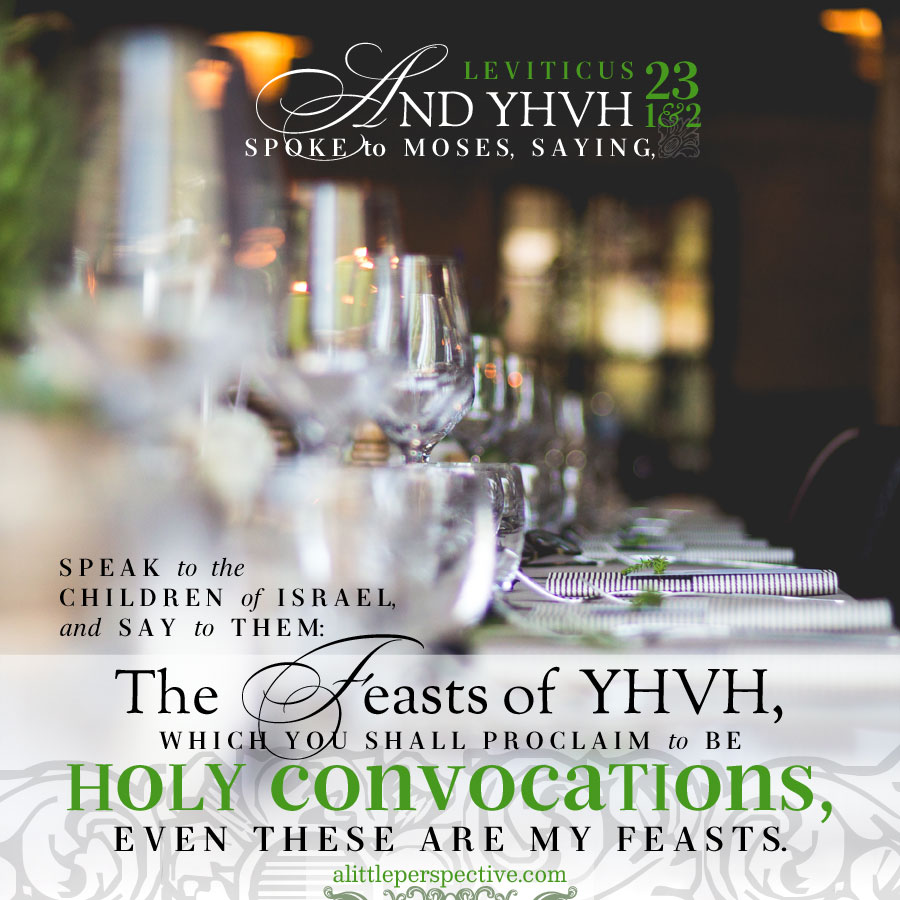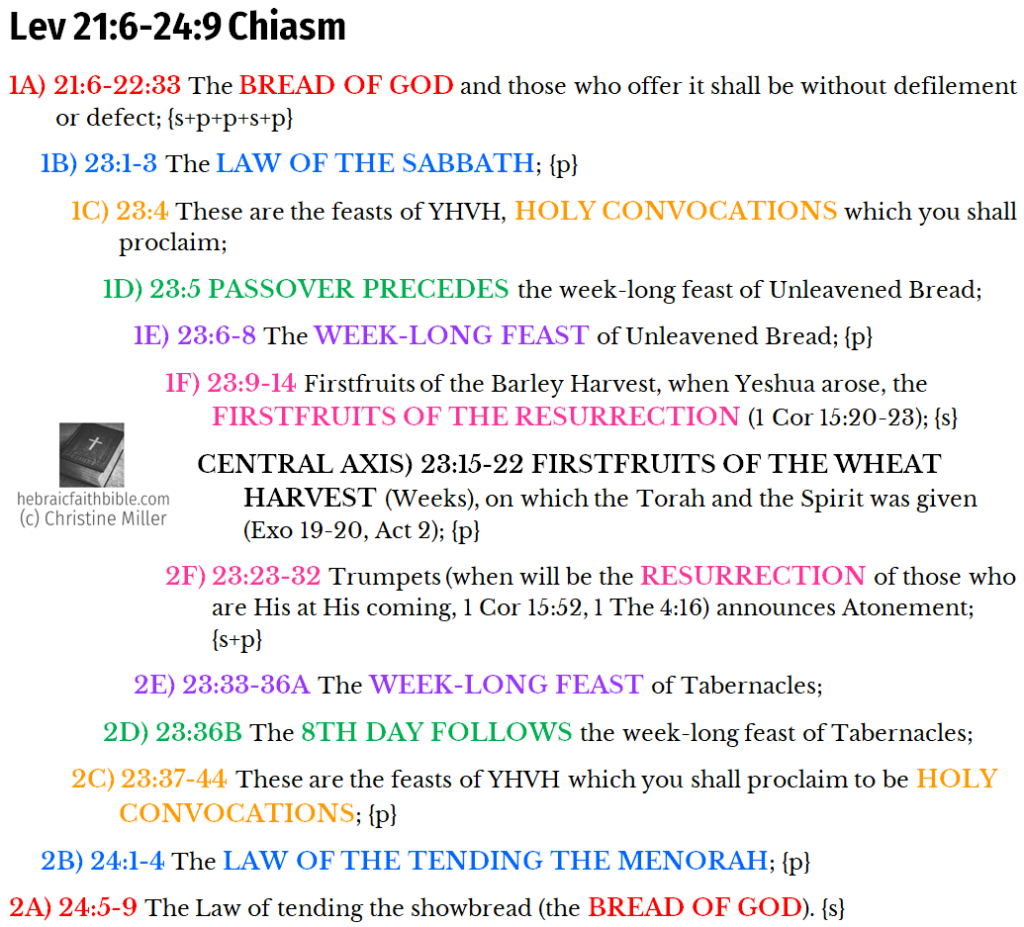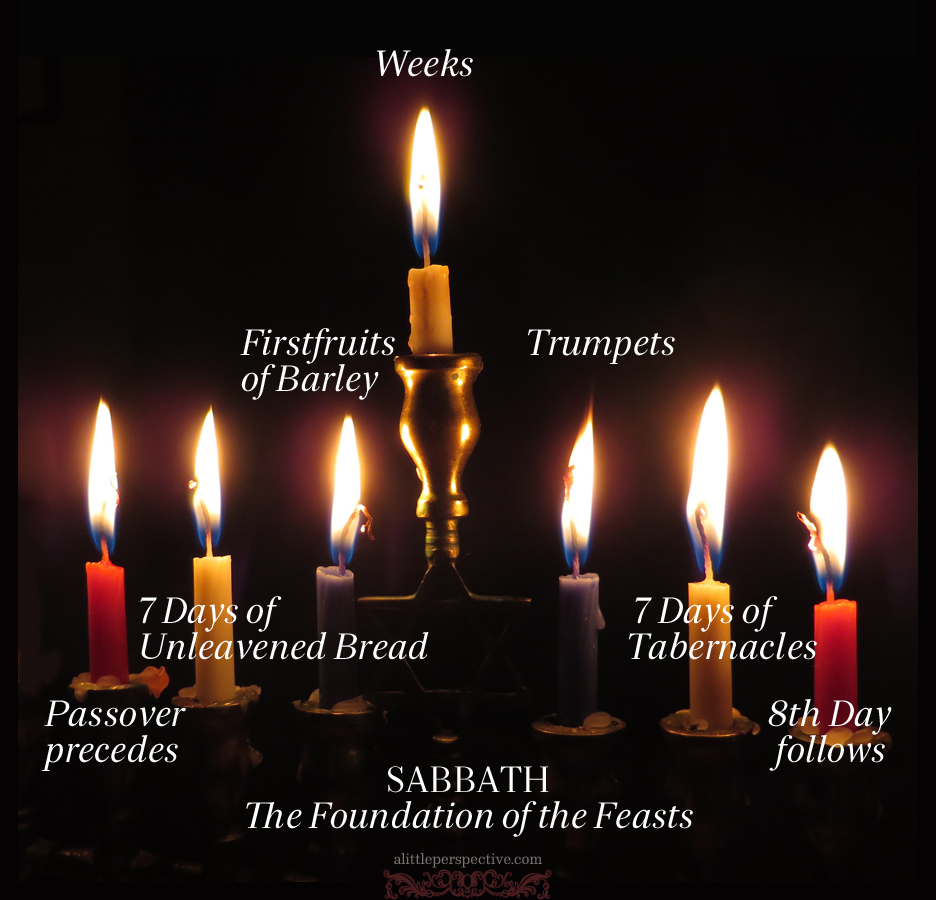Read Leviticus 22 and 23 at Bible Gateway.
The Hebrew paragraph divisions for our chapters today are:
Lev 22:1-16 {p} The law of the separation of the holy things + offerings given to the LORD
Lev 22:17-25 {s} No sacrifice with a defect shall be offered as the bread of God;
Lev 22:26-33 {p} Sacrifices become acceptable on the eighth day + the LORD sanctifies Israel
Lev 23:1-3 {p} The law of the Sabbath
Lev 23:4-8 {p} The law of Passover and Unleavened Bread
Lev 23:9-14 {s} The law of the Firstfruits of the Barley Harvest
Lev 23:15-22 {p} The law of the Firstfruits of the Wheat Harvest
Lev 23:23-25 {s} The law of Trumpets
Lev 23:26-32 {p} The law of Atonement
Lev 23:33-44 {p} The law of Tabernacles
Lev 22 continues in the same vein as our reading from yesterday: the spotlessness and separateness (the true meaning of “holy”) of the LORD’s things, and His sacrifices. The theme of Lev 23 is “the feasts of the LORD,” (Lev 23:2). “Feasts” in Hebrew is moed, Strong’s H4150. We have seen this word before! It is the same word used beginning in Exodus and throughout Torah, for the tent of meeting (moed). The concordance says it means an appointed place or time. These feasts are the LORD’s appointed times, or appointments, that He has set aside to meet with His people!
In Egypt, where Israel came from, and in Canaan, where Israel was going, they celebrated feast days to their gods. In fact, we still have many of these same feast days on our national calendars – still, after thousands of years! The LORD’s feast days, however, are not like the feast days of the idols. His feast days (or “holy days,” i.e., holidays) have been established by Him from the foundation of the world. For in Gen 1:14, God tells us that He created lights in the firmament of the heavens to “be for signs and seasons (moed), and for days and years;” — to mark (the meaning of “sign” in Hebrew) the LORD’s appointed times (moed). Morever, each of His feasts prophesy of Messiah Yeshua in amazing ways.
God’s paragraph divisions help us identify the LORD’s appointed times of meeting:
The Sabbath on the seventh day (Lev 23:1-3 {p}). This day is so hallowed to the LORD, that even its instructions in Lev 23 are separated (the Hebrew meaning of “holy”) from the instructions for the rest of the feast days by a {p} strong paragraph division.
1. Passover (Lev 23:4-5) in the evening of the 14th of the 1st biblical month.
2. Unleavened Bread (Lev 23:6-8 {p}) for 7 days beginning on the 15th of the 1st biblical month. Notice that the instructions for Passover and Unleavened Bread are combined into a single paragraph.
3. Firstfruits of the Barley Harvest (Lev 23:9-14 {s}) which falls on the day after the Sabbath (Sunday) that falls during the week of Unleavened Bread.
4. Weeks (Lev 23:15-22 {p}) or the Firstfruits of the Wheat Harvest, which falls 7 weeks from the Firstfruits of the Barley Harvest, also on the day after the Sabbath (Sunday).
5. Trumpets (Lev 23:23-25 {s}), which falls on the 1st day of the 7th month.
6. Atonement (Lev 23:26-32 {p}), which falls on the 10th day of the 7th month.
7. Tabernacles (Lev 23:33-44 {p}), or the Firstfruits of the Fruit Harvest, for 7 days beginning on the 15th day of the 7th month.
The feast days also star as the central axis of an interesting Chiastic Structure:
The B pair is the most interesting: the Law of the Sabbath/ the Law of tending the menorah. They are forced together by the elements surrounding them, but how do these pair?
When we do not neglect Sabbath, the foundation of the annual feast cycle (and by extension, the annual feasts) our observance shines a continual light of witness. Isn’t God and His word amazing!
For further reading:
The Feasts of YHVH index of studies
Moed, “Set time or place,” Strong’s H4150
Feast: Hebrew Word study – Brad Scott
Israel’s Feasts and Their Fullness – Batya Wootten



















Leave a Reply